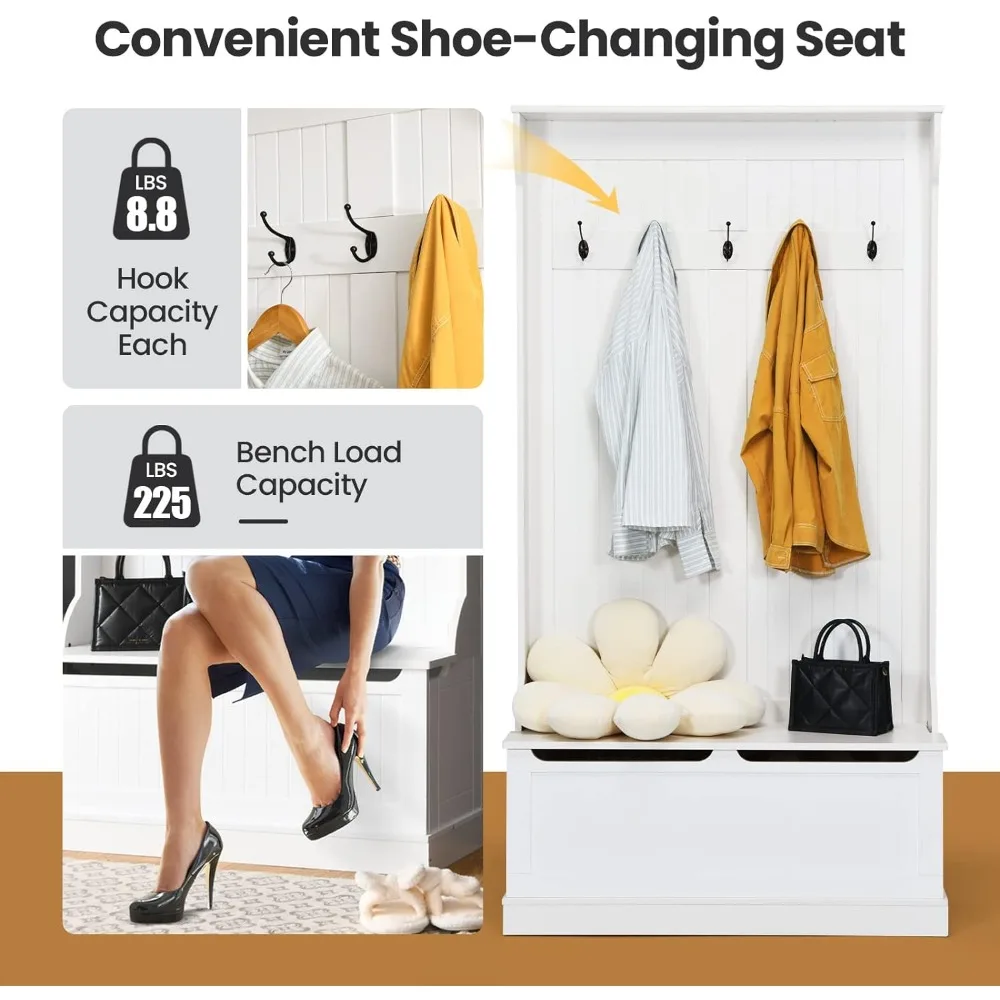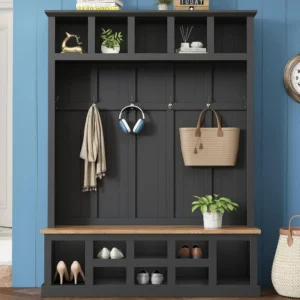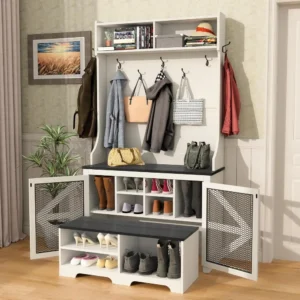Why Wall-Mounted Hook and Bench Combinations Are Game-Changers for Home Organization
A wall-mounted hook and bench combination is a multi-functional furniture piece that combines seating with vertical storage, specifically designed for entryways, mudrooms, and hallways. These clever units attach to your wall, creating an organized landing zone for everyday essentials without consuming valuable floor space.
These versatile solutions address multiple home organization challenges simultaneously:
- They eliminate entryway clutter by providing dedicated spots for coats, bags, and accessories
- They offer convenient seating for putting on or removing shoes
- They maximize vertical space utilization, perfect for homes of any size
- They create a functional “drop zone” that keeps daily items accessible but organized
Unlike traditional freestanding hall trees or separate benches and coat racks, these wall-mounted combinations float above the floor, creating an airier feel while optimizing your available square footage. Implementing space-saving entryway solutions can completely transform how your home’s entrance functions and feels.
Studies show that entryway clutter ranks among the top five household organization pain points, with 78% of homeowners reporting frustration with managing coats, shoes, and bags in these high-traffic areas. By installing a thoughtfully designed wall-mounted system, you can create a more welcoming first impression while significantly improving your daily coming-and-going routine.
The strategic combination of hooks and seating creates an intentional organization system that encourages family members to maintain tidiness naturally. Creative space-saving entryway ideas like these can make even the smallest foyers feel spacious and purposeful.
Key Benefits of Installing a Wall-Mounted Hook and Bench System
Space Optimization for Small Areas
Wall-mounted combinations typically extend just 12-16 inches from the wall compared to freestanding units that can protrude 18-24 inches or more. This space-saving design makes them perfect for narrow hallways and compact entryways where every inch matters. Many homeowners with limited square footage find small benches for entryways to be essential for maintaining an organized, functional home.
Enhanced Organization Efficiency
These systems create a designated place for everything—coats on hooks, bags on pegs, shoes under the bench, and small essentials in baskets. This natural organization flow eliminates the “where did I put my keys?” morning scramble by establishing consistent homes for your everyday items.
Convenient Seating Solution
Having a dedicated spot to sit while putting on or removing shoes prevents awkward balancing acts and makes coming and going more comfortable, especially for children and older adults. This simple addition transforms your daily routine in subtle but meaningful ways.
Reduced Floor Clutter
By elevating storage off the ground and utilizing vertical wall space, these combinations keep your walkways clear and prevent trip hazards. The floor space beneath the bench remains accessible for shoe storage or decorative baskets, maximizing every available inch.
Elevated Aesthetic Appeal
A thoughtfully chosen hook and bench system serves as an attractive focal point while providing essential function. Instead of a jumble of coats tossed over chairs or piles of shoes, these units create an organized, intentional look that enhances your home’s first impression.
Wall Protection
Dedicated hooks prevent damage to walls that often occurs from repeatedly hanging items on door frames or leaning heavy bags against painted surfaces. This protective function extends the life of your wall finishes while maintaining organization.
Potential Home Value Enhancement
Practical, attractive storage solutions are increasingly important to home buyers. A well-designed entryway storage system signals that the home has been thoughtfully organized and cared for, potentially increasing resale value and appeal.
Assessing Your Needs: Finding the Right Combination for Your Space
Before selecting your ideal wall-mounted hook and bench system, ask yourself these key questions to ensure you choose the perfect match for your space and lifestyle:
How much wall space can you dedicate? Measure your available wall area, noting width and height. Most wall-mounted combinations require 3-5 feet of width for comfortable use, but compact versions for tight spaces start at around 24 inches wide.
Who will be using the system? A single person might need just 2-3 hooks, while a family of four might require 6-8 hooks at varying heights for adults and children. Consider how the compact bench selection process affects your daily routine and accessibility needs.
What items will you be storing? Take inventory of your typical entryway items. Do you need storage for many bulky winter coats or just a few light jackets? Will you be storing backpacks, purses, dog leashes, or sports equipment? Understanding your storage volume helps determine the number and strength of hooks required.
What’s your home’s aesthetic? Consider your existing decor and architectural style. Do you prefer sleek modern lines, rustic farmhouse charm, or industrial elements? Your wall-mounted system should complement your home’s overall design language.
What weight capacity do you need? If you’ll be hanging heavy winter coats or multiple bags on each hook, you’ll need robust mounting hardware and sturdy construction materials. Similarly, the bench should support the weight of adults comfortably if it will serve as regular seating.
Will children need to access the hooks? If so, consider options with lower hooks or adjustable components that can be reached by little ones to encourage independence and organization habits from an early age.
Complete this quick assessment before shopping to narrow your options and find the perfect system for your specific needs.
Types of Wall-Mounted Hook and Bench Combinations to Consider
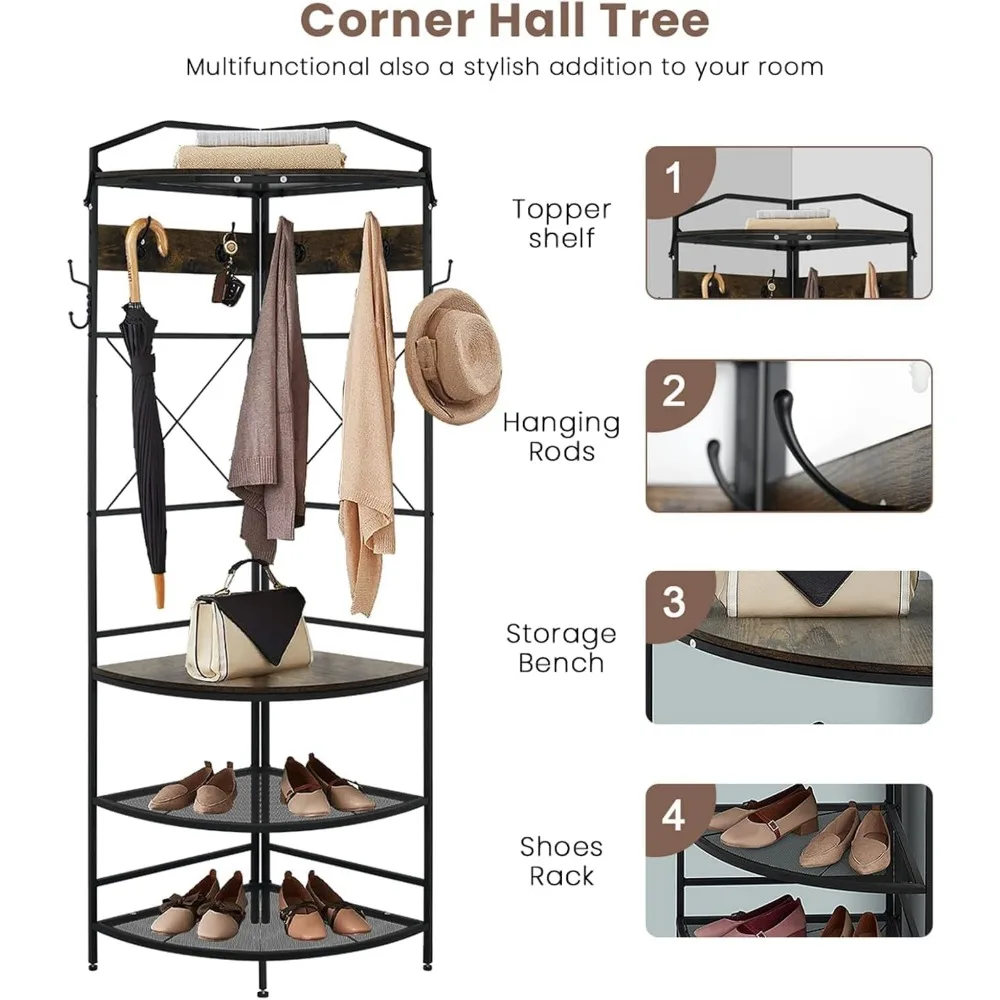
All-in-One Integrated Units
These comprehensive systems feature a connected panel, hooks, and bench in one cohesive unit. They offer the most streamlined appearance and simplest installation since you’re mounting a single piece rather than multiple components.
Features:
– Complete matching aesthetic throughout
– One-time installation process
– Often include additional features like shelving or mirrors
– Available in various styles from modern to traditional
Our collection of integrated hall tree solutions offers excellent examples of these complete systems designed to maximize functionality while minimizing installation complexity.
Semi-Mounted Hall Trees
These hybrid pieces feature a wall-mounted back panel with hooks while the bench portion rests on the floor. This design distributes weight more evenly, making them suitable for homes where wall mounting heavyweight items might be problematic.
Features:
– Less wall support required than fully mounted options
– Generally more stable for heavier use
– Often include more substantial bench storage underneath
– Easier to relocate if needed
Modular Systems
These customizable arrangements allow you to select and arrange individual components—separate hook rails, shelves, and benches—to create a personalized configuration perfect for your specific space and needs.
Features:
– Expandable as your needs change
– Can be arranged to fit unusual wall spaces
– Mix-and-match capability for personalized design
– Ideal for awkward spaces like corner hall tree arrangements
Minimalist Floating Bench and Hook Rail Combinations
For those who prefer clean, contemporary design, these sleek options feature simple floating benches paired with streamlined hook rails mounted above, creating an airy, uncluttered look.
Features:
– Modern aesthetic with minimal visual weight
– Creates an illusion of more space
– Often more affordable than all-in-one units
– Great for small spaces and apartments
Enhanced Storage Options
These systems go beyond basic hooks and seating to incorporate additional organization features like cubbies, drawers, shoe storage, or overhead shelving.
Features:
– Maximum storage capacity for busy households
– Specialized compartments for different items
– Often include built-in shoe storage solutions
– Great for homes without dedicated mudrooms
Each type offers different advantages depending on your space constraints, aesthetic preferences, and organizational needs.
Essential Features to Look For in Quality Hook and Bench Systems
Hook Design and Functionality
The hooks are the workhorses of your entryway system, so their design and construction deserve careful consideration:
- Quantity and spacing: Look for hooks spaced 6-8 inches apart to prevent crowding of items. Most households need at least 4-6 hooks for adequate storage.
- Material strength: Solid metal hooks (steel, iron, brass) offer superior strength compared to plastic or thin wire options. Cast iron hooks typically support 10-15 pounds each, while heavy-duty steel can handle up to 25 pounds per hook.
- Style variations: Consider double-prong designs for multiple items, rounded edges for fabric protection, or decorative finials for aesthetic appeal.
- Weight capacity: Verify the weight rating for each hook, particularly if you’ll hang heavy winter coats or loaded backpacks.
- Safety profile: Choose hooks with slightly rounded ends if children will be using them to prevent accidental injuries from sharp points.
Bench Construction and Comfort
The bench component provides both seating utility and often additional storage:
- Seating surface: Choose between plain wood for durability and easy cleaning, or upholstered cushions for comfort during longer sitting periods.
- Storage integration: Consider options with open shelving beneath for shoes, closed cubbies for private items, or flip-top storage for seasonal accessories.
- Ergonomic dimensions: Look for benches 16-18 inches high and 12-15 inches deep for comfortable adult seating. Too high or too shallow will feel awkward for daily use.
- Weight capacity: Quality benches should support at least 250 pounds safely. Check manufacturer specifications, especially for wall-mounted options.
- Maintenance requirements: Sealed wood surfaces offer the easiest cleaning, while fabric cushions may require occasional stain treatment.
The combination of bench designs with integrated hooks and storage creates multifunctional solutions that maximize utility while minimizing space requirements. When evaluating features, consider your daily routines and the specific items you’ll be storing to ensure the system meets your practical needs while complementing your home’s aesthetic.
Materials Matter: Choosing the Right Components for Longevity
The materials used in your wall-mounted hook and bench system significantly impact its durability, appearance, and maintenance requirements:
Solid Wood Options
Pros:
– Natural beauty with unique grain patterns
– Exceptional durability when properly finished
– Can be refinished if damaged
– Adds warmth and character to spaces
– Generally supports higher weight capacity
Cons:
– Higher price point than engineered alternatives
– May expand or contract with humidity changes
– Requires occasional maintenance to preserve finish
– Heavier to mount securely
Oak, maple, and walnut offer excellent durability with distinctive grain patterns, while pine provides a lighter weight, more affordable alternative with a casual, rustic appeal.
Engineered Wood Alternatives
Pros:
– More consistent and uniform appearance
– Often more affordable than solid wood
– Less susceptible to warping or cracking
– Typically lighter weight for easier installation
– Available in many finishes and styles
Cons:
– Cannot be refinished if damaged
– Generally supports less weight than solid wood
– May deteriorate faster in high-humidity areas
– Visible damage is usually permanent
MDF (Medium Density Fiberboard) provides a smooth, paintable surface ideal for modern designs, while plywood offers better durability and strength for heavier use areas.
Metal Components
Pros:
– Superior strength-to-weight ratio
– Resistant to moisture damage
– Contemporary aesthetic appeal
– Minimal maintenance requirements
– Excellent longevity
Cons:
– Can feel cold or industrial without wood elements
– May show scratches more visibly
– Limited color options compared to wood
– Potential for rust in extremely humid environments
Steel offers maximum strength for heavy-use hooks, while aluminum provides a lighter-weight alternative for decorative elements.
When considering various hall tree bench features, material selection should balance aesthetic preferences with practical concerns like durability, maintenance requirements, and weight capacity. Higher-quality materials typically translate to longer-lasting performance, especially in high-traffic entryways where the furniture faces daily use.
The hardware used for mounting deserves equal consideration—stainless steel screws and heavy-duty brackets provide superior support compared to standard hardware, particularly for systems that will hold substantial weight.
Installation Essentials: Setting Up Your Wall-Mounted System Properly
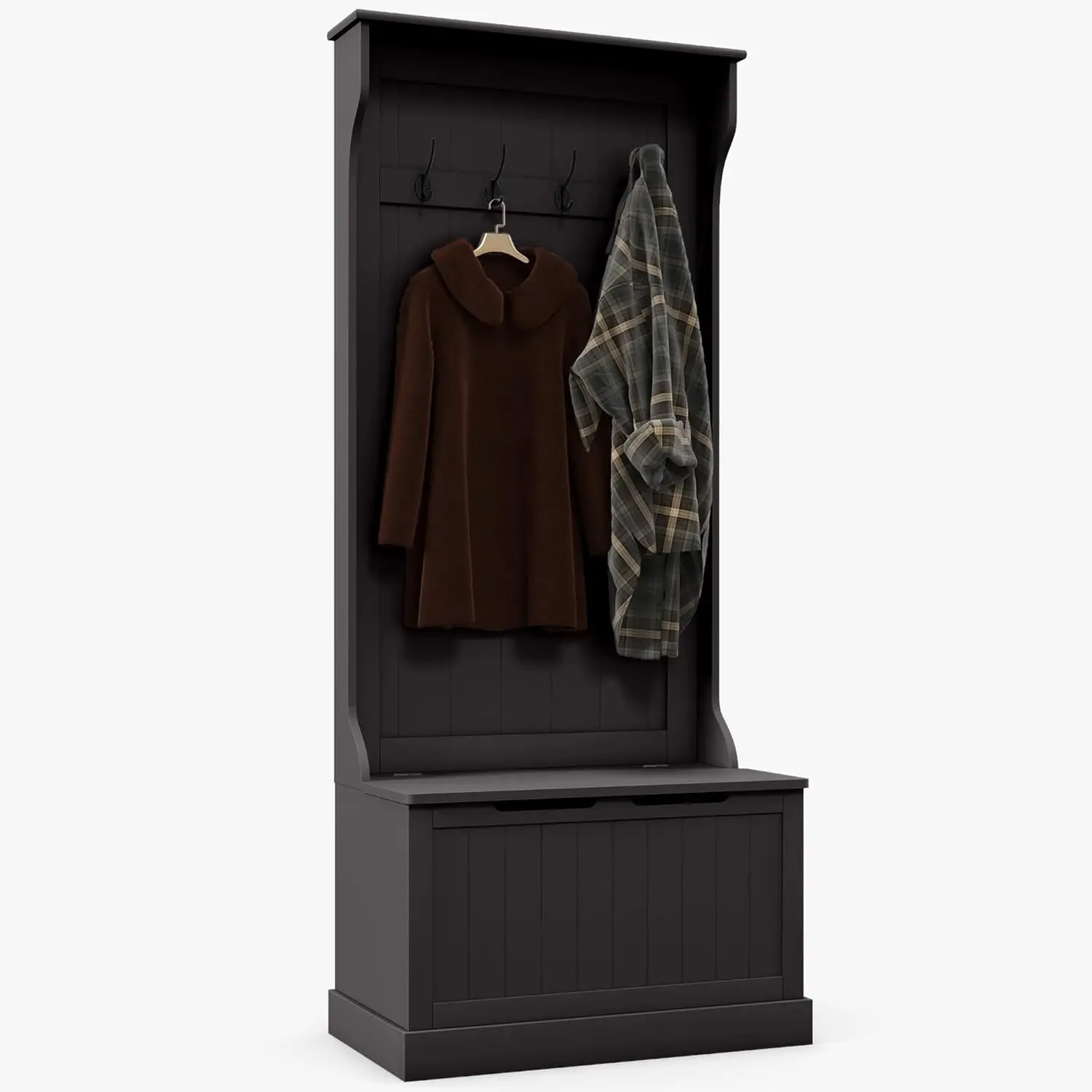
Proper installation ensures your wall-mounted system remains secure and functional for years to come. Follow these guidelines for a successful setup:
Essential Tools:
– Stud finder
– Level
– Drill with appropriate bits
– Screwdriver
– Measuring tape
– Pencil for marking
– Helper for holding larger pieces
Finding Wall Studs:
Start by locating and marking wall studs using a stud finder. Most wall-mounted systems require attachment to at least two studs for adequate support. Mark stud locations clearly with a pencil before beginning installation.
Selecting Proper Hardware:
– For drywall with stud mounting: Use 2.5-3 inch wood screws
– For masonry walls: Use masonry anchors appropriate for the wall material
– For plaster walls: Consider toggle bolts in addition to stud mounting
– Always use hardware rated for at least 1.5 times your expected weight load
Optimal Placement:
– Hook rails: Mount approximately 60-65 inches from the floor for average adults
– For families with children: Consider a second, lower row of hooks at 40-45 inches
– Bench height: Standard 16-18 inches from floor to seat surface
– Allow at least 12 inches of bench width per person for comfortable seating
Safety Considerations:
– Always verify weight capacity ratings before installation
– Test the mounted system by applying gradual pressure before loading with items
– Check for any wall damage or unusual construction that might affect mounting
– Re-tighten all hardware after a few weeks of use
For those preferring a complete solution without installation concerns, our mudroom coat rack bench collection includes options with simplified mounting requirements. However, for heavyweight systems or unusual wall constructions, professional installation might be worth the investment to ensure safety and longevity.
Remember that proper installation is critical not just for functionality but also for safety, particularly for systems that will hold substantial weight or be used by children.
Design Inspiration: Styling Your Hook and Bench Combination
Your entryway organization system can be both functional and a stylish design statement. Here are inspiring approaches to elevate your space:
Modern Minimalist
Embrace clean lines, neutral colors, and uncluttered design. Look for systems with hidden hardware, smooth surfaces, and floating bench designs. Pair with simple metal hooks in matte black or brushed nickel. Complement with monochromatic accessories and perhaps one bold geometric accent piece.
Rustic Farmhouse
Celebrate natural textures and vintage-inspired details with distressed wood finishes, wrought iron hooks, and simple bench designs. Our farmhouse entryway bench collection offers perfect examples of this popular style. Add galvanized metal baskets, cotton cushions in buffalo check patterns, and perhaps a simple wreath above to complete the look.
Industrial Chic
Combine raw materials like reclaimed wood with metal elements featuring exposed hardware and pipe-style hook designs. Look for bench supports with visible brackets and weathered wood tones. Accessorize with wire baskets, canvas storage bins, and vintage-inspired signage.
Coastal Retreat
Create a breezy, relaxed vibe with whitewashed or pale blue finishes, natural rope accents, and hook designs inspired by nautical elements. Add striped bench cushions in navy and white, seagrass baskets, and perhaps a mirror with a rope frame to enhance the coastal atmosphere.
Mid-Century Modern
Focus on clean lines, tapered legs, and warm wood tones like walnut or teak. Look for hook designs with slight curves and organic shapes. Pair with geometric cushions in bold colors like mustard yellow or teal, and add a sunburst mirror above to complete the retro-inspired look.
For any design style, consider these complementary elements to enhance both function and beauty:
– A slim mirror to create the illusion of more space
– Wall art that coordinates with your overall design theme
– Accent lighting to highlight the area
– A small tray for keys and sunglasses
– Indoor plants to add life and color
Remember that your entryway creates the first impression of your home’s interior style, so choosing a hook and bench combination that reflects your personal aesthetic helps establish design continuity throughout your living space.
DIY Options: Creating a Custom Hook and Bench System
Building your own wall-mounted hook and bench system allows for complete customization while potentially saving money. Consider these aspects before embarking on a DIY project:
Benefits of DIY Approach
- Perfect size customization for unusual spaces
- Material selection precisely matched to your home
- Significant cost savings (typically 40-60% compared to pre-made options)
- Personal satisfaction of creating a custom piece
- Ability to modify designs as your needs change
Basic Materials for a Simple Project
- 1×10 or 1×12 lumber for the bench seat
- 1×4 boards for support brackets
- Decorative hooks of your choice
- Wood stain or paint
- Heavy-duty mounting hardware
- Wood screws and wood glue
Skill Assessment
Before starting, honestly evaluate your woodworking abilities:
– Beginner level: Simple floating bench with separate hook rail
– Intermediate level: Integrated bench and backboard with multiple hook options
– Advanced level: Custom design with integrated storage, cubbies, or drawers
General Process Overview
- Measure your space and create a detailed plan with dimensions
- Cut wood pieces according to your measurements
- Sand all pieces thoroughly for smooth, splinter-free surfaces
- Assemble the bench structure using wood glue and screws
- Apply finish (stain or paint) and allow proper drying time
- Mount securely to wall studs using appropriate hardware
- Attach hooks at proper heights and spacing
Partial DIY Alternatives
If a complete build seems overwhelming, consider these hybrid approaches:
– Purchase a pre-made bench and add custom hook rails above
– Mount separate floating shelves with hooks underneath
– Repurpose vintage elements like old door frames with added hooks
– Customize a basic store-bought unit with paint and upgraded hardware
Whichever approach you choose, prioritize proper mounting techniques and weight capacity considerations to ensure safety and longevity.
Must-Have Accessories to Enhance Your Wall-Mounted System
The right accessories transform your hook and bench combination from merely functional to exceptionally convenient. Consider these additions to maximize the utility of your entryway organization:
Decorative Baskets: Place on the bench or underneath to corral small items like gloves, scarves, or pet accessories. Look for sizes that fit your space precisely to maintain a clean appearance.
Key Hooks or Small Shelves: Install a dedicated spot for keys, sunglasses, and mail near the main hook system to create a complete “landing zone” for daily essentials.
Entryway Mirror: Mount a mirror above or beside your hook system to serve dual purposes—checking your appearance before leaving home and visually expanding the space to make it feel larger.
Bench Cushions: Add comfort and style with a cushion sized for your bench. Choose weather-resistant, washable fabrics for durability in this high-traffic area.
Boot Trays: Place underneath the bench to contain moisture and dirt from wet shoes. Look for options with raised edges to prevent water from spilling onto flooring.
Wall Art: Incorporate art pieces or photography above or beside your hook system to personalize the space and enhance your home’s aesthetic.
Strategic Lighting: Add sconces or a small lamp near your entryway organization system to ensure the area is well-lit for finding items during early mornings or evenings.
Learning to effectively organize a small entryway bench with these strategic accessories can dramatically improve both the functionality and appearance of your space. The key is selecting items that serve clear purposes while maintaining a cohesive design aesthetic that complements your hook and bench combination.
Coat Rack Shoe Bench, Corner Entryway Bench, Corner Hall Tree, Shoe Bench for Entryway
$313.58 Select options This product has multiple variants. The options may be chosen on the product pageBench with Hooks and Storage, Entryway Hall Tree, Mudroom Bench with Cubbies, Mudroom Bench with Shoe Storage
$818.38 Select options This product has multiple variants. The options may be chosen on the product pageEntryway Coat Rack Bench, Entryway Hall Tree, Farmhouse Mudroom Bench, Mudroom Bench with Shoe Storage
$805.09 Select options This product has multiple variants. The options may be chosen on the product pageBench with Hooks and Storage, Entryway Coat Rack Bench, Entryway Hall Tree, Mudroom Bench with Shoe Storage, Mudroom Coat Rack Bench
$793.73 Select options This product has multiple variants. The options may be chosen on the product pageFarmhouse Entryway Bench, Modern Entryway Bench
$1,514.84 Select options This product has multiple variants. The options may be chosen on the product pageCoat Rack Shoe Bench, Entryway Coat Rack Bench, Entryway Hall Tree, Wood Entryway Bench
$479.82 Select options This product has multiple variants. The options may be chosen on the product page
Maintenance Tips for Long-Lasting Performance
Proper care ensures your wall-mounted hook and bench system remains beautiful and functional for years. Follow these simple maintenance routines:
Regular Cleaning
- Wood surfaces: Dust weekly with a soft cloth and clean monthly with a mild wood cleaner appropriate for your finish type
- Metal hooks: Wipe with a slightly damp cloth and dry immediately to prevent water spots or rust
- Upholstered elements: Vacuum regularly and treat stains promptly with appropriate fabric cleaners
Hardware Maintenance
- Check and tighten all screws and mounting hardware every 3-4 months
- Apply a drop of lubricant to any moving parts like folding hooks annually
- Inspect wall mounting points for any signs of stress or damage
Weight Management
- Distribute heavy items across multiple hooks rather than overloading one
- Avoid allowing children to hang or swing from hooks or the bench
- Be mindful of cumulative weight on wall-mounted systems
Seasonal Care
- Rotate seasonal items to prevent permanent stress on hooks
- Deep clean the entire unit when switching between winter and summer gear
- Apply a fresh coat of protective finish to wood elements annually if needed
Refresh Options
- Touch up paint or stain as needed to address worn areas
- Replace individual hooks if they become damaged or loose
- Update bench cushions or accessories seasonally for a fresh look
With proper care, quality wall-mounted systems can maintain their beauty and functionality for 10+ years, making them a worthy investment in your home’s organization.
Top Questions About Wall-Mounted Hook and Bench Systems
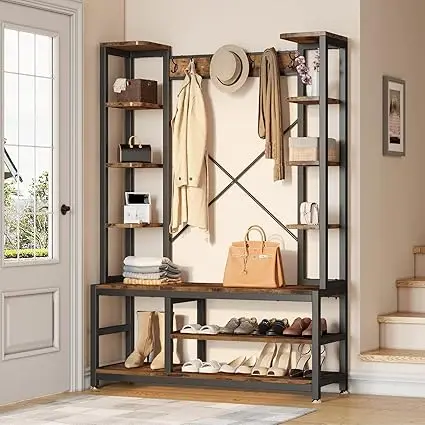
What weight can these systems typically support?
Most properly installed wall-mounted hook and bench systems can support 250-350 pounds on the bench portion and 10-25 pounds per hook, depending on materials and mounting methods. Always check manufacturer specifications and ensure mounting into wall studs or using appropriate wall anchors for your specific wall type.
Can I install these in a rental property?
Yes, with some considerations. Look for systems that mount with fewer, larger screws to minimize wall damage. Some modular options can be mounted with specialized anchors that leave smaller holes. Always check your lease agreement, and consider free-standing alternatives if mounting isn’t permitted.
How much wall space do I need at minimum?
For a functional system serving one person, allow at least 24 inches of width. For a family, 48-60 inches provides comfortable spacing. Height requirements typically range from 60-72 inches from floor to top of the hook system, with the bench portion occupying the bottom 16-18 inches.
Are these safe for homes with young children?
Yes, with proper precautions. Choose systems with rounded hook edges, secure mounting, and consider installing some hooks at child-friendly heights to encourage independence. Ensure the bench is firmly attached and teach children not to climb or hang on the system.
Can I add components over time?
Many modular systems allow for expansion. Look for brands that offer compatible pieces so you can start with basics and add matching components as needs change or budget allows. Some space-efficient mudroom bench solutions are specifically designed with expansion capability.
What’s the best height for hook installation?
For adult use, install hooks 60-65 inches from the floor. For mixed households, consider a staggered approach with some hooks at 45-50 inches for children. The bench portion typically sits 16-18 inches from the floor for comfortable seating.
Can these systems work in unusual spaces like corners?
Absolutely! Corner hook and bench systems are specifically designed for these challenging spaces. Custom or modular systems can also be configured to work in irregular areas, maximizing organization in previously unused corners.
Common Mistakes to Avoid When Choosing and Installing
Underestimating Weight Requirements
Problem: Selecting a system that can’t handle your household’s actual usage, leading to sagging benches or pulled-out hooks.
Solution: Be realistic about how many heavy coats, backpacks, and bags will hang simultaneously. Choose heavy-duty construction and mounting hardware rated well above your expected load.
Improper Wall Mounting
Problem: Attaching only to drywall without hitting studs, resulting in wall damage and potential collapse.
Solution: Always locate and utilize wall studs when mounting. For areas between studs, use appropriate heavy-duty wall anchors rated for the expected weight load.
Choosing Inadequate Materials
Problem: Selecting lightweight materials that can’t withstand daily use in a high-traffic area.
Solution: Invest in quality materials like solid wood, sturdy metal hooks, and proper hardware. The entryway experiences more wear than almost any other home area, justifying higher-quality materials.
Incorrect Height Placement
Problem: Mounting hooks too high for shorter family members or too low for taller ones, discouraging consistent use.
Solution: Consider all users and potentially install hooks at varied heights. Ensure the bench height (typically 16-18 inches) allows comfortable seating for adults while remaining accessible to children.
Insufficient Hook Spacing
Problem: Placing hooks too close together, causing items to overlap and creating a cluttered appearance.
Solution: Allow 6-8 inches between hooks for adequate spacing of coats and bags. For bulky winter items, even more space might be necessary.
Style Misalignment
Problem: Choosing a system that clashes with your home’s existing aesthetic, creating a disjointed first impression.
Solution: Select styles, finishes, and materials that complement your overall home design. The entryway sets the tone for your entire home, so visual cohesion matters.
Prioritizing Form Over Function
Problem: Selecting a beautiful but impractical system that doesn’t address your specific storage needs.
Solution: List your must-have features before shopping and ensure the system you choose meets those functional requirements first, with aesthetic considerations as a close second.
Transform Your Entryway: Before and After Success Stories
The Tiny Apartment Entryway
Before: A narrow hallway with no storage led directly into the living space. Coats draped over furniture, shoes cluttered the floor, and keys went missing regularly in this 650-square-foot apartment.
After: A 30-inch floating bench with four hooks above created a designated landing zone without consuming precious floor space. A small mirror and key hook completed the transformation, creating a functional mini-mudroom that maintained an open feel.
The Growing Family Solution
Before: A chaotic entryway with children’s backpacks, sports equipment, and adult work bags piled on the floor created daily frustration for this family of four.
After: A six-foot wall-mounted system with eight hooks at varying heights, a bench with shoe storage underneath, and labeled baskets for each family member revolutionized their morning routine. School items now had dedicated spots, reducing forgotten homework and misplaced permission slips.
The Rental Revival
Before: A plain, builder-grade hallway with no character or storage function felt uninspiring and cluttered with everyday items.
After: A modular system with minimal wall anchoring transformed the space while respecting rental restrictions. The bench with removable cushions added color, while strategically placed hooks kept essentials organized and off the floor.
The Narrow Hallway Makeover
Before: A 36-inch wide hallway felt cramped and dysfunctional with a traditional coat rack taking up valuable floor space.
After: A slender wall-mounted bench with overhead hooks utilized vertical space without protruding too far into the walkway. The hall now feels more spacious while providing even more storage than before.
These transformations showcase how thoughtfully selected wall-mounted hook and bench combinations can dramatically improve both the function and appearance of challenging entry spaces of all sizes.
Why Investing in Quality Makes a Difference for Long-Term Satisfaction
When choosing between budget options and premium wall-mounted hook and bench combinations, consider these compelling reasons to invest in quality:
Superior materials translate directly to longevity—quality solid wood and metal components typically last 10-15 years compared to 2-4 years for budget particleboard options. This extended lifespan makes the initial investment much more economical when calculated as cost-per-year of use.
Premium construction methods like dovetail joints, reinforced mounting points, and properly sealed finishes withstand daily wear in high-traffic entryway areas. These details prevent common budget furniture failures like wobbling benches, loose hooks, or delaminating surfaces.
Well-designed pieces maintain their visual appeal despite years of use. Quality finishes resist scratching, fading, and wear patterns, keeping your entryway looking fresh and intentional rather than tired and damaged.
Quality systems often feature adaptable designs with removable components, adjustable elements, or expansion possibilities. This flexibility allows your storage solution to evolve with your household needs rather than requiring complete replacement when circumstances change.
From an environmental perspective, buying one quality piece that lasts decades creates substantially less waste than replacing inferior products multiple times. This sustainability aspect adds another dimension of value beyond the immediate functional benefits.
The entryway creates crucial first impressions of your home, both for guests and for yourself when returning each day. A thoughtfully selected, well-crafted hook and bench combination elevates this experience, transforming a formerly cluttered stress point into an organized, welcoming transition space that sets a positive tone for your entire home.

